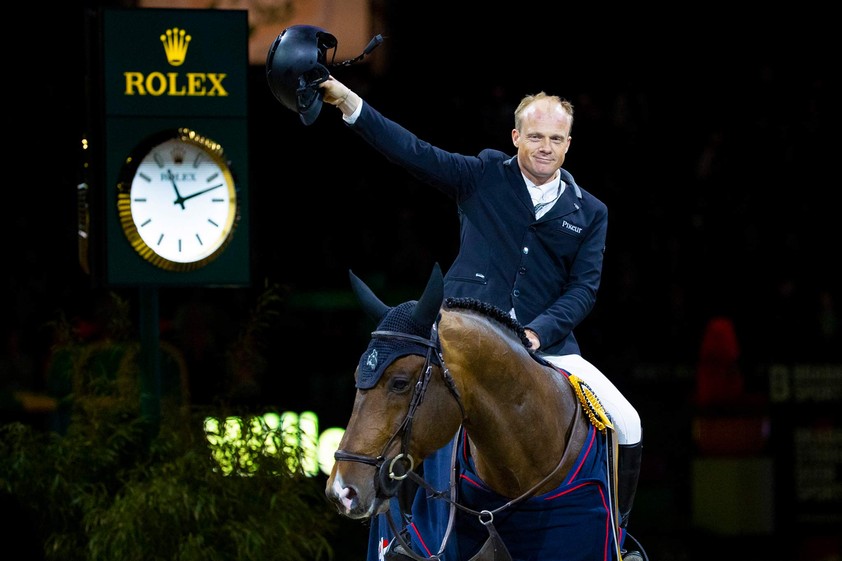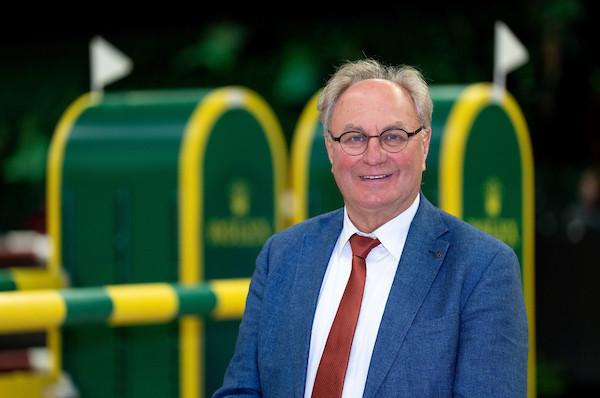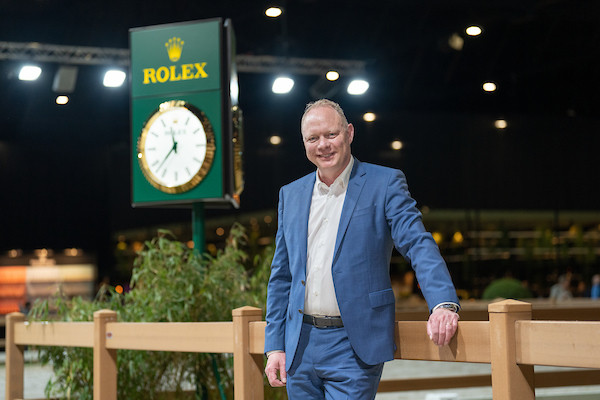Willem Greve and Grandorado TN N.O.P. win the VDL Groep Prize
Held under the bright lights of the Brabanthallen, 39 riders, representing 13 nations, contested Friday’s feature class – the VDL Groep Prize – on the second day of The Dutch Masters 2023. This impressive line-up featured no less than 8 of the world’s current top 10-ranked riders, including the Rolex Grand Slam of Show Jumping Live Contender McLain Ward, World No.1 Henrik von Eckermann and the Rolex Grand Prix defending champion Daniel Deusser. In addition, seven Rolex Testimonees and 12 riders from the home nation contested Louis Konickx’s masterfully designed course.
First to enter the arena was Britain’s Scott Brash, the only winner of the Rolex Grand Slam of Show Jumping, riding the nine-year-old stallion Hello Valentine, who set the standard with a flawless clear round. Second to go, Simon Delestre with the feisty Cayman Jolly Jumper, followed suit to ensure a jump-off. To the delight of the Dutch crowd, three riders from the home nation secured a place in the second round, including 60-year-old Loewie Joppen, who put in an impressive performance aboard Havel van de Wolfsakker Z.
12 horse and rider combinations successfully made it through to the jump-off, over a shortened course of 8 fences. Brash set the early pace as the first to go, with a clear round in a time of 42.10 seconds. His lead looked to be in jeopardy as Delestre set-off meaning business, coming home in an exceptional 37.54 seconds, but accruing four faults enroute. Janne Friederike Meyer-Zimmermann, the only woman in the jump-off, temporarily took over pole position as third to go, but with Delestre’s speedy round, the following riders knew the time was beatable.
The lead changed several times before Dutchman, Willem Greve, set the crowd alight riding Grandorado TN N.O.P., stepping up the pace once more to post a clear in a time of 36.62 seconds. It was left to Rolex Testimonee Harry Charles, as last to go, to attempt to knock Greve off the top spot, but despite an impressive display of speed and agility, his time of 37.93 was only good enough for second place.
Speaking after the class, Greve said: “I am extremely happy to win in front of my home crowd. The first round was big, but it was fair on the horses – it is the second biggest class of the show so it should be a real test, and I thought it made for a great competition. I have had this horse since he was three-years-old, so I have a produced him throughout the levels, which makes this win even more special. He is just such a super horse, and I have worked hard over the winter to improve his rideability and his fitness – he is feeling fabulous now, so I am looking forward to Sunday.”
When asked about his tactics going into the jump-off, the Dutchman said: “I was near the end of the class so I managed to watch a few other combinations before I went in. I thought that if I got a good jump at the second fence, that I could do seven strides to the next and then take advantage of his big stride down to the last fence and it worked out very well!”
Walking the Course with:
Louis Konickx
For you, why is The Dutch Masters such a special show?
The Dutch Masters is such a special show as it draws the best show jumpers in the world to compete here in ‘s-Hertogenbosch, and this is incredible to witness. In 1994, when we hosted the first World Cup™ Final, it was a very extraordinary day and one that will go into the history books. The fans that come to this show are so vibrant, passionate and knowledgeable, and this really adds to how unique it is. As a course designer, the lead up to a show can be challenging as you are questioning whether the courses will be a correct fit, but you just have to trust in yourself.
Can you tell us a little bit about the course that you have designed for Sunday’s Rolex Grand Prix?
I have designed this year’s Rolex Grand Prix course with my assistant Quintin Maertens – who is a very talented individual. We are extremely happy with the size of this year’s arena as it allows us to build lots of challenges and different distances. We have some tough lines that require the riders to be totally precise in their rhythm, speed and power.
How many clears are you expecting?
Sometimes the number of clears can be viewed as a dilemma for course designers. In Holland, and in many other countries, fans like it when there are lots of clears in the first round as it results in an interesting jump-off, especially if someone from their own country makes it through. I think I will be happy if there are around 10 people in Sunday’s jump-off.
Which rider do you predict will win Sunday’s Rolex Grand Prix?
The first round of the Rolex Grand Prix can play to the strength of certain riders, such as Harrie Smolders who is incredibly consistent. However, the pressure instantly increases in a jump-off, and it is a different atmosphere, so it is certain riders like France’s Julien Epaillard, who are so fast, that can came out on top and win here. I hope that the winner will be a Dutch or Belgian rider, or even a legend of the sport such as Marcus Ehning.
How did you become a course designer?
In the area that I grew up in, there was a course designer whose courses the riders did not like– he tried hard but unfortunately he was not that talented. To succeed in course designing, you need to understand the space and how best to utilise it in each arena. Whilst I was still studying, so when I was 25-years-old, I remember approaching him with a suggestion of what could be changed in that particular arena. He then suggested that I pursue my interest in course designing.
I continued to ride alongside studying to become a course designer so this lengthened the process but it allowed me to create an understanding from the riders perspective as well. As I progressed, people started to trust me, which resulted in me working on better and more renowned shows. I remember Arno Gego from CHIO Aachen contacting me saying that they had a show in my local area and he asked whether I would be interested to work as an assistant to him. This was a great steppingstone as it allowed me to become an assistant to the main course designer for some of the most renowned shows in the world, which was an invaluable learning experience.
When and where was the first course that you designed, as head course designer?
The first big international course that I designed as head course designer was at CHIO Rotterdam. Emile Hendrix, the show director, and Frank Kemperman gave me the opportunity to design the course and emphasised that they would trust me and support my suggestions. This was an important moment in my career, and it is incredible to think that it was for Rolex. Frank Rothenberger also helped design the course for that show.
What are your passions away from course designing?
I am still riding, it is still important for me to follow this passion of mine.When my daughters were small, I took up playing guitar again – in fact, I have joined a new group now, and we were actually rehearsing yesterday evening, I am definitely the oldest but it is a very fun hobby.
Finally, I used to sail a huge amount with my brother when we were teenagers.,I I have started sailing again. Once I was in Lausanne, Switzerland looking out onto Lake Geneva and in that moment called my brother to tell him of my urge to get a sail boat. So, I currently have a decent sized sail boat, which myself and my daughters have great fun on!
Which course designer has inspired you the most throughout your career?
The course designer who has inspired me the most is Arno Gego. He has contributed so much and influenced a significant amount to our profession. He has worked hard to create a base that all course designers can work up from and he has inspired so many people to push their standards higher.
Could you tell us about your relationship with Gerard Lachat?
When I reflect back on my life, it is noticeable that my life has been linked to Rolex competitions and this is brilliant. I met Gerard in San Patrignano at a 5* competition, where I was invited to help design the course. We have built some of the greatest courses in the world together such as Rolex Grand Prix at CHI Geneva and here in ‘s-Hertogenbosch as well as courses at the FEI World Championship in Herning and so many more. We have built a friendship that goes beyond our profession and we still ride together.
The Rolex Grand Slam was formed in 2013 and will this year celebrate its 10-year anniversary; how beneficial has this initiative been for the sport of show jumping?
The Rolex Grand Slam has really benefited the sport of show jumping as it provides variety with the different Majors that have been encapsulated within it – each has their own unique and captivating atmosphere. As a course designer, it is great to see that every Major has their own signature which makes the show so special. As there are only four Majors every year, it increases the importance and prestige around them. As a result, the Rolex Grand Slam of Show Jumping attracts the best riders from all over the world. It is extremely influential in the sport and has become a dream of many riders to compete at the Majors. In addition, it has promoted riders to be tactical with their horses and to make sure that they are fresh for each of the Majors – this has actually benefitted the horses, as the riders do not over-jump them to ensure that they are at their peak levels of performance for these shows.
Word from the Organiser:
Marcel Hunze
You must be delighted that this year’s edition of The Dutch Masters is going ahead with full capacity?
It is great that after several difficult years due to the pandemic that we can have a full edition of The Dutch Masters with crowds, hospitality and the entertainment village all returning. The after parties are also promising to be fun this year!
How has planning been going for this year’s event?
The planning has been going very well! We have seen a huge amount of interest from the fans that are looking forward to attend again. As a result, we are expecting a lot of crowds and exhibitors to be at the show to watch the best riders of the world – so everything is going smoothly at the moment.
Is there anything new this year that The Dutch Masters has introduced?
In 2020 a lot of changes were made, but unfortunately the event had to be cancelled only one-hour before the show was meant to start, due to the Covid-19 pandemic. For this year’s edition, we have implemented these changes, so it is a great opportunity for those attending to see the differences in the set up. The team have added new restaurants, have improved facilities for the audience, and have increased the size of the warm-up arena for the riders. We hope that everyone will enjoy these changes that we have made.
What qualities do you look for in team members? And what makes a successful team?
There is a considerable team working on the show each year – there are about 1,500 staff working during the event. We always try to build a trusting environment between management, staff and volunteers so we can work effectively with each other. Our goal is to build a long-term relationship with the team and that everyone is aware of the high standards we are looking for at The Dutch Masters. This therefore allows the effective running of the event.
What is your advice to someone who wants to get into the sporting events industry?
My main advice is to make sure that they gain a multitude of experience in the sports industry, and to not only focus on the area that they are interested in. This will allow the individual to gain a variety of skills and knowledge that will benefit them later in their chosen sport as well as understand how the industry works in general. Finally, it is vital to have an eye for detail as this will benefit and contribute to the successful running of an event.
For you, what makes a successful major sporting event?
At a successful major sporting event, a balance between fans, sponsors and media needs to be achieved. I believe that for sponsors, it is vital for the facilities to be amazing but if there are limited fans, the atmosphere is not the same which can result in an unsuccessful event. Similarly, if an event does not have sponsors that support and invest in the event, it too will be unsuccessful. In my opinion, creating a successful major sporting event is a blend of sponsors, athletes, media and fans that are in attendance, as they all rely on each other at the end of the day.
Later in the year will mark 10 years since the launch of the Rolex Grand Slam of Show Jumping; how successful has it been and how has it positively changed the sport?
We are incredibly proud that The Dutch Masters became associated with the Rolex Grand Slam of Show Jumping in 2018. It is an unbelievable concept, and it is incredibly important to the sport of show jumping. It has elevated the sport in both its prestige, as well as the level of riders who are drawn to compete. This year at the show, eight out of the top ten are attending. It also ensures that the highest quality of the event is delivered and that we as event organizers do not stray away from this goal. It is a great concept for riders, fans and sponsors – it has definitely been an absolute success.
Do you and The Dutch Masters organisers take inspiration from any of sport’s other major competitions, e.g., in tennis or golf?
It is definitely beneficial to observe the organisers of other major sport competitions. We also organise an ATP and WTA tennis event in the Netherlands alongside The Dutch Masters. It is a combined tournament that takes place on grass ahead of The Championships, Wimbledon. We apply and use several interchangeable skills and methods when organising both tennis and show jumping events as both can benefit from each other and this has enabled the successful running of events.



